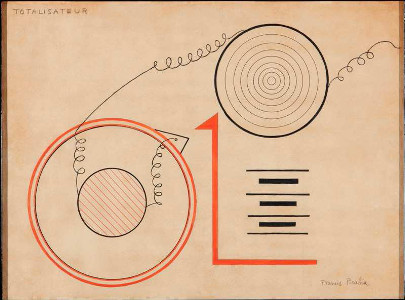Locus Solus
26 Oct 2011 - 27 Feb 2012
LOCUS SOLUS
Impressions of Raymond Roussel
Curators: Manuel Borja-Villel, João Fernandes and François Piron
Organised by: Museo Reina Sofía, in conjunction with Museu de Arte Contemporânea de Serralves
26 October, 2011 - 27 February, 2012
Related activities: A propósito de... Locus Solus. Impressions of Raymond Roussel
Locus Solus is the first exhibition to be held in Spain on the figure and influence of Raymond Roussel (Paris, 1877 - Palermo, 1933), the author of poetic, novelistic and theatrical works without precedent in the history of literature. Roussel is known for both the singularity and exuberance of his narrative and visual universe and also for the complex methodology he developed and then perfected over time. This methodology was based on the exploration of the inventive potential of homonymy and word play, all from the conviction that an artistic/literary work does not need to contain anything real, that it can be exclusively a combination of imaginary objects. In a text published posthumously, How I wrote certain of my books, Roussel explains the process he used. The author, who always kept his distance from the avant-garde and from the literary movements of his times (because, in the words of André Breton, he was "fully determined to follow no inclination other than that of his spirit") reveals in the aforementioned text that he started out by inventing two phrases that were phonetically almost identical but had very different meanings, to later try to write a story that could start with one of them and end with the other.
Using variations of this process he created his two most emblematic works, Locus Solus and Impressions of Africa, which give this exhibition its name. The show analyses the influence that Raymond Roussel has had on modern and contemporary art, by looking at a broad array of works in a variety of formats (paintings, photos, sculptures, ready-mades, installations, videos...) by about thirty different artists. His enormous influence was recognised early on by surrealists and other creators linked to the historical avant-garde – including Marcel Duchamp, who went so far as to describe him as "he who points the way" – and since then it has done nothing but grow, with an authentic myth being generated around this artist who, nonetheless, remains quite unknown.
The exhibition shows how Raymond Roussel's aesthetic-literary undertakings, so complex and ambitious and with their strange blend of conceptual rigor and linguistic delirium, have been a primary source of inspiration to numerous visual artists (Salvador Dalí, Francis Picabia, Allen Ruppersberg, Rodney Graham...) and also to authors from other fields and disciplines, ranging from philosophy (Michel Foucault) to literature (John Ashbery, Michel Butor, Julio Cortázar...), including music and even ethnographic research. The work of Roussel can thus be used as a point of departure for an oblique and transversal reading of 20th century art.
Impressions of Raymond Roussel
Curators: Manuel Borja-Villel, João Fernandes and François Piron
Organised by: Museo Reina Sofía, in conjunction with Museu de Arte Contemporânea de Serralves
26 October, 2011 - 27 February, 2012
Related activities: A propósito de... Locus Solus. Impressions of Raymond Roussel
Locus Solus is the first exhibition to be held in Spain on the figure and influence of Raymond Roussel (Paris, 1877 - Palermo, 1933), the author of poetic, novelistic and theatrical works without precedent in the history of literature. Roussel is known for both the singularity and exuberance of his narrative and visual universe and also for the complex methodology he developed and then perfected over time. This methodology was based on the exploration of the inventive potential of homonymy and word play, all from the conviction that an artistic/literary work does not need to contain anything real, that it can be exclusively a combination of imaginary objects. In a text published posthumously, How I wrote certain of my books, Roussel explains the process he used. The author, who always kept his distance from the avant-garde and from the literary movements of his times (because, in the words of André Breton, he was "fully determined to follow no inclination other than that of his spirit") reveals in the aforementioned text that he started out by inventing two phrases that were phonetically almost identical but had very different meanings, to later try to write a story that could start with one of them and end with the other.
Using variations of this process he created his two most emblematic works, Locus Solus and Impressions of Africa, which give this exhibition its name. The show analyses the influence that Raymond Roussel has had on modern and contemporary art, by looking at a broad array of works in a variety of formats (paintings, photos, sculptures, ready-mades, installations, videos...) by about thirty different artists. His enormous influence was recognised early on by surrealists and other creators linked to the historical avant-garde – including Marcel Duchamp, who went so far as to describe him as "he who points the way" – and since then it has done nothing but grow, with an authentic myth being generated around this artist who, nonetheless, remains quite unknown.
The exhibition shows how Raymond Roussel's aesthetic-literary undertakings, so complex and ambitious and with their strange blend of conceptual rigor and linguistic delirium, have been a primary source of inspiration to numerous visual artists (Salvador Dalí, Francis Picabia, Allen Ruppersberg, Rodney Graham...) and also to authors from other fields and disciplines, ranging from philosophy (Michel Foucault) to literature (John Ashbery, Michel Butor, Julio Cortázar...), including music and even ethnographic research. The work of Roussel can thus be used as a point of departure for an oblique and transversal reading of 20th century art.

